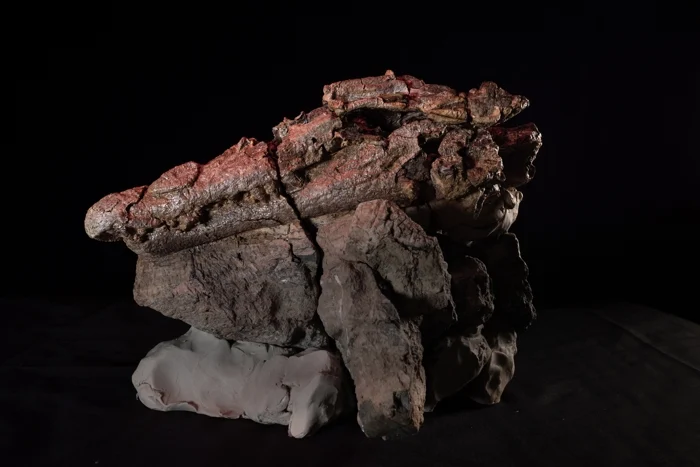Scientists have confirmed that a massive 93-million-year-old crocodile found in Central Queensland had devoured a baby dinosaur based on remains found in its fossilised stomach contents.
They dubbed the crocodile relative Confractosuchus sauroktonos, which is a mouthful (much like the dinosaur that the giant crocodilian swallowed almost whole), but that’s because it includes a lot of information about the fossil.
The cumbersome name — a new genus and species — translates from words in Latin and Greek that collectively mean “broken crocodile dinosaur-killer,” according to the study.
“Dinosaur-killer” came from the fossil’s gut contents, while “broken” refers to the stony matrix surrounding the fossil, which shattered during excavation in 2010 and revealed smaller bones inside the croc’s abdomen, according to a statement released by the Australian Age of Dinosaurs Museum in Winton, Queensland.
The word “broken” in the crocodile’s name refers to the massive, shattered boulder from where the fossils were uncovered, said the scientists from the Australian Nuclear Science and Technology Organisation.
After the fossils were first discovered in 2010, early studies detected bones of the small chicken-sized juvenile dinosaur in the gut. The juvenile reptile was an unidentified ornithopod, a group of medium to large plant-eating dinosaurs. The partially-digested dinosaur may have weighed around 1kg to 1.7kg.
Scientists say a “staggering” 35 per cent of the crocodile was preserved, including a “near-complete skull”, showing the arrangement of teeth, although the tail and hind limb were missing.

The skull of Confractosuchus sauroktonos.
(Australian Age of Dinosaurs Museum)
Crocodilians first coexisted with dinosaurs beginning in the Triassic period (251.9 million to 201.3 million years ago), and prior evidence suggests that they found some dinosaurs to be delicious. Tooth marks on fossilized dinosaur bones (and in one case, a tooth embedded in bone) hint that some crocodilians dined on dinosaurs, either hunting them or scavenging their remains.
Most of the dinosaur’s skeleton was still connected after it was swallowed, but as the dinosaur-killer munched its meal, it bit down so hard that it broke one of the ornithopod’s femurs in half, and it left a tooth embedded in the other femur, the researchers reported.
While the croc’s stomach contents show that its last meal was a small dinosaur, the predator likely snapped up other Cretaceous animals, too. However, dinosaurs were probably a regular part of their diet, according to the study.
“It is likely dinosaurs constituted an important resource in the Cretaceous ecological food web,” lead study author Matt White, a research associate at the Australian Age of Dinosaurs Museum, said in the statement.
“Given the lack of comparable global specimens, this prehistoric crocodile and its last meal will continue to provide clues to the relationships and behaviors of animals that inhabited Australia millions of years ago.”
Scientists believe further analysis of this ancient crocodile and its last meal would continue to shed more light on the relationships and behaviours of animals that inhabited Australia millions of years ago.
Sources:
Abdominal contents reveal Cretaceous crocodyliforms ate dinosaurs

